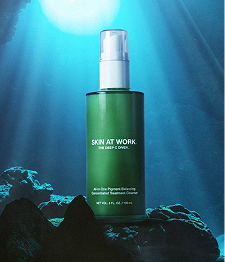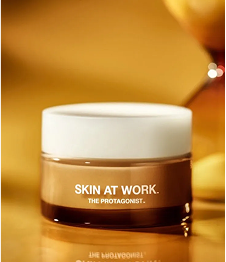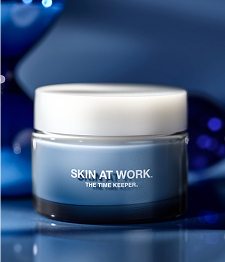Glycolic acid has gained a lot of attention over the last few decades because of its strong exfoliating and anti-aging properties. It became popularized in the late 90s and early 2000s by some of the first “Doctor Dermatologist Brands” because it is incredibly effective at accelerating the natural exfoliation process.

Glycolic Acid belongs to a family of smoothing ingredients called AHAs or Alpha Hydroxy Acids. AHAs can be derived from many different fruits or plants in nature, among other things. As you might guess, some AHAs are more harsh or gentle than others.
You will often see products with 10% Glycolic Acid that are meant to be cycled into your routine. But, there are relatively strict rules about using Glycolic as it can cause unwanted side effects and expose your skin to further aging.
Let's take a closer look at Glycolic Acid and exploring what it is, the potential negative impacts and available alternatives that are known to be gentler and kinder to your skin without compromising efficacy.
What is Glycolic Acid and Should You Avoid it?
Glycolic acid is commonly sourced from sugar cane. It has an extremely small molecular composition which allows it to penetrate the top layers of the skin quite effectively. It speeds up skin cell turnover by breaking down the bonds that are holding the dead skin cells at the top of your dermis together.
Once these dead cells are whisked away, newer younger cells are revealed which impart a fresher, brighter complexion and diminish the appearance of fine lines, wrinkles and pigmentation.
Think of your skin like a wall of bricks. AHAs, including Glycolic Acid, will dissolve the mortar in between those bricks allowing the “wall” to come crumbling down. Those outside walls or cells have been exposed to all sorts of elements and environmental aggressors so they are dull and tired looking.
Additionally, dead skin cells tend to amplify the look of wrinkles to the naked eye. AHAs act like a catalyst for your skin’s natural exfoliation process which reveals that youthful glow.
It’s because of this process that Glycolic Acid is largely praised for its exfoliation abilities. Yet, these same potent properties also pose a lot of risks. Over exfoliation can lead to sun or skin sensitivity and using it with other products may create irritation.
Having a high percentage of this chemical in formulas can lead to discomfort, redness and further aging of your skin.

Glycolic Acid Doesn’t Often Mix Well With Others
Most over the counter formulas offer 10% Glycolic Acid concentrations meant to be used once or twice weekly because of their powerful exfoliation abilities. For this reason, there are a range of ingredients that “don’t play well in the sandbox” with Glycolic Acid. When combined with common ingredients it stunts their effectiveness.
For instance, mixing it with Vitamin B3 (Niacinamide) may neutralize pH levels, rendering both ingredients less effective or possibly useless.
Additionally, mixing Glycolic Acid with certain types of Vitamin C both reduces its efficiency and may exacerbate existing skin problems such as irritation. Interactions between these ingredients compromise the intended benefits of products in your skincare regimen.
Another red flag combination for Glycolic Acid is Retinol which we have written about before. Both ingredients can cause redness, irritation and flaking but using them together might make your skin beyond angry.
Glycolic Acid Requires A Lot of Attention
Because 10% Glycolic Acid can be such a strong exfoliant, its inclusion in your skincare routine can be cumbersome and challenging to fit into your busy lifestyle.
- Sun Sensitivity: Glycolic Acid shouldn’t be used before any anticipated sun exposure. If you are going to be gardening, playing tennis or going to the beach, it’s advised not to use it several days before intense sun exposure, because it makes your skin more vulnerable to the sun’s harsh rays.
- Maintenance: Have you ever forgotten to do your weekly exfoliation? Yeah, us too. Getting off schedule leaves your skin dull and tired looking – and somehow ALWAYS right before an important meeting or event. It’s best to exfoliate a few days before, especially for skins that are prone to redness.
- Time and Research: As we mentioned above, formulas with 10% Glycolic Acid can be risky with many different ingredients. We only mentioned a few but there are many more. This leads to lots of time researching ingredient contraindications and possible adverse reactions to make sure your skin doesn’t break out or “blow up”.

Side Effects of Glycolic Acid
Products that have 10% Glycolic Acid or higher should be used with common sense caution. Those with sensitive, breakout prone or dry skin need to be particularly aware of skincare products that contain a high concentration of Glycolic Acid. They come with a high risk of the following side effects:
- Rosacea
- Excessive flaking
- Disruption to skin’s moisture barrier
- Extreme Dryness
- Increased Sun Sensitivity
- Irritation and Redness
- Breakouts
- Itchiness
Gentler Alternatives for Exfoliation
Now, AHAs are not all bad news and exfoliation is still beneficial for your skin, but SKIN AT WORK doesn’t believe in highly concentrated Glycolic Peels or Masks. We believe applying a gentle, persistent daily exfoliator contained in your regular skincare products will help remove dirt, dead skin cells and unclog pores without causing irritation or any of the above side effects.
Here are some “gold standard” options for achieving the same result without potential side effects.
- Prickly Pear Extract: Prickly Pear Extract is an oil derived from a succulent plant in the cactus family. This extract has many proven benefits for your skin. It contains fatty acids and vitamins that are extremely beneficial for improving skin health. It helps gently renew and smooth your skin’s surface by extracting dirt and clearing pores without causing irritation.
- Fruit acids made from the pulp of tropical plants: This trio is made up of banana, yellow mombin, and mango. Each of these fruits contain properties that help to naturally nourish your skin. They provide persistent yet gentle daily exfoliation that imparts a shocking softness.
Both of these ingredients are featured in THE PROTAGONIST All-In-One Brightening Hero Concentrated Serumoisturizer! Made up of effective, gentle ingredients this formula works to strengthen your skin barrier while making it appear brighter than ever before.
- Lactic Acid: This ingredient, derived from sour milk or fermented fruits, is another great exfoliator. It works to shed dead skin cells while keeping your skin hydrated. Using this instead of Glycolic Acid will help smooth your skin's texture without removing natural oils.
SKIN AT WORK features this ingredient in THE TIME KEEPER All-In-One Lipid Volumizing Concentrated Repair Cream: A nighttime formula that gently exfoliates and promotes healthy skin renewal.
No More Irritating Products
Using high concentrations of Glycolic Acid on your skin is sort of like doing a 6 hour gym workout. You show up with the hopes of losing weight and feeling better yet you put yourself at risk for pulling a muscle, dehydration and extreme soreness the next day. It’s not a sustainable or smart solution.
Replacing Glycolic Acid with daily, gentle and persistent exfoliators (akin to a daily skin workout) like Prickly Pear, Tropical Fruit Acid trio and a gentle lactic acid contained in your existing skincare routine are an easy way to ensure you are getting the right amount of exfoliation to give your skin a youthful “lit from within” radiance without potential negative side effects.
Here's to your best skin!







